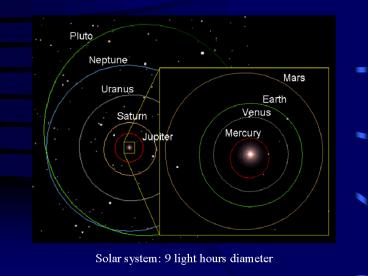General Astrophysical Concepts: Astronomical length scales and time scales PowerPoint PPT Presentation
Title: General Astrophysical Concepts: Astronomical length scales and time scales
1
Solar system 9 light hours diameter
2
Spiral galaxy 80,000 light years diameter
3
Coma cluster of galaxies 2.5 million light years
across
4
Survey of distant galaxies 5 to 9 billion
light-years away
5
Cosmic Microwave Background Radiation (after-glow
from the Big Bang) - edge of the observable
Universe 14 billion light years away
6
General Astrophysical Concepts Astronomical
length scales and time scales
- First principles of cosmology
- The universe is (a) HOMOGENOUS (b) ISOTROPIC
- Homogeneity implies isotropy,
- But isotropy does NOT imply homogeneity
7
Kepler's laws of motion
- (1) Orbits of planets follow ELLIPSES with the
Sun at one of the two foci - (2) Equal areas are swept out in equal intervals
of time - (3) P2 a R3 or P2 C R3 / M
- where P is the period of the orbit, R is the
radius' of - the orbit, and M is the mass of the central
object (Sun)
8
Elliptical path/orbit followed by planet
Sun
?
9
Sample Pop-quiz
- Which of the following statements is TRUE
- When galaxies collide, it is very common for
stars to smash into each other - Primordial density fluctuations grow under the
influence of the electromagnetic force - Large galaxies are assembled by the merging of
smaller galaxies - The furthest galaxies we can see from Earth are
100 billion light years away
10
Forces of Nature
- Newton's Laws of Motion
- Inverse square law of forces
- Fundamental forces (4)
(3) Weak nuclear force Example
ß-decay or top bottom quark (4)
Strong nuclear force Example force
that binds protons neutrons in
atomic nuclei
(1) Gravitational force Example
falling apple (2) Electromagnetic force
Example horseshoe magnet
11
The Milky Way and Other Galaxies Like It
- Overview of its constituents
- Dynamics (and mass) of a typical spiral galaxy
- The Milky Way
- Application of Kepler's third law (math
application) - - The Solar System and Milky Way
compared - - How many stars does the Milky Way
contain?
12
The Detailed Structure of a Spiral Galaxy
13
Electromagnetic Radiation
- Propagation of Energy in the Form of Oscillating
Electric - and Magnetic Fields
- Speed of propagation (in vacuum) c 300,000
km/s - Frequency ? number of oscillations per second
- Unit of frequency s-1 or Hertz (Hz)
- Wavelength ? distance traveled during one
oscillation - Unit of wavelength meter (m), Angstrom (1
Å 10-10 m) - c ?? or ? c/? or ? c/?
- ? ? are inversely proportional to each
other
14
(No Transcript)
15
Electromagnetic Spectrum
- Progression of frequency or wavelength
- Radio, millimeter, sub-millimeter,
microwave, infrared, optical, ultraviolet, X-ray,
gamma rays - Optical/visible white light spectrum (rainbow
colors) - Red Orange Yellow Green Blue Indigo Violet
- Order of decreasing wavelength, increasing
frequency
16
Atmospheric Windows
- Optical, sub-millimeter, millimeter, and radio
wavelengths - Impact on astronomy (and on human evolution!)
17
Sample Pop-quiz
- Which of the following statements is FALSE
- When galaxies collide, it is very common for
stars to smash into each other - Primordial density fluctuations grow under the
influence of the gravitational force - Large galaxies are assembled by the merging of
smaller galaxies - The furthest galaxies we can see from Earth are
about 10 billion light years away
18
Black Body Radiation
- Perfect emitter of radiation perfect absorber of
radiation - Energy radiated per second depends on
temperature - L AsT4 or L 4pR2sT4 (sphere of
radius R) - where L luminosity (in erg/s) A
surface area - s Stefan's constant T temperature (in
Kelvin C 273) - Quality' of radiation (? or ? or color) depends
on the - black body temperature (Wien's law)
?peakT constant (?peak is inversely
proportional to T)
19
Black Body Radiation
20
Wave-Particle Duality
- Radiation consists of energy bundles (quanta)
called photons - Energy of each photon E h?
- where h Planck's constant, ?
frequency of radiation - Energy of each photon depends on color'
(?, ?) of radiation - The more luminous a source of radiation, the more
photons it emits per second
21
Atomic Energy Levels
- An atom in Quantum Mechanics discrete energy
levels - Transitions between levels emission
absorption lines
22
Continuum, Emission Line, and Absorption Line
Radiation

